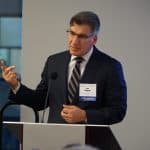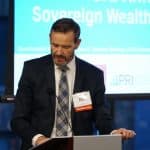CFA Society New York’s hosted 3rd Annual Sovereign Wealth Fund with a solid turnout on September 18th, 2017.
Moderator
DUNCAN BONFIELD, Chief Executive Officer, International Forum of Sovereign Wealth Funds
Panelists
Fiona Mackenzie, Head of External Investments, New Zealand Superannuation Fund
Kevin Bong, Senior Vice President, GIC
Stella Ojekwe-Onyejeli, Chief Risk Officer & Executive Director, Nigeria Sovereign Investment Authority
Mohammed Saif Al-Sowaidi, Americas Head, Qatar Investment Authority
Abdiel Santiago, Chief Executive Officer, Fondo de Ahorro de Panamá, Sovereign Wealth Fund of the Republic of Panama
Key Points of the Discussion Organized by Topics Included:
Strategic Asset Allocation
Based on empirical research, asset allocation derivatives 80 – 90% of the overall return generation. No surprise that the moderator raised this as the first question as well as spent fair amount of time discussing this particular topic. One Sovereign Wealth Fund (SWF) managers stated that their approach is based on a long-term (L/T) horizon with a referenced portfolio of 80% global equities and 20% global fixed income with key decisions in asset allocation. Another SWF manager shared similar approach with a target L/T rate of return without generating undue risks, allocating 65% on global equities and 35% on global fixed incomes and the referenced portfolio reflects the client’s risk profile. With two components of alphas (1. Market-timing alpha and 2. Idiosyncratic alpha.). Interestingly enough, one SWF manager uses what he called a direct investment approach and another SWF manager with a very different asset allocation mix 20% global equities and 80 global fixed income.
Currency Risks Management
In terms of currency risks, I find many of the SWFs’ share similar approach, though, not identical. The approaches tend to focus on limiting multi-currency risks and geo-political risks. Derivatives are used as well to hedge currency risks, but it was stressed that to limit hedging costs. One SWF in particular mentioned their domestic currency is pegged to the US Dollars, essentially, they focus on US dollars denominated investments.
External Asset Managers (EAM)
Most of the SWFs’ use external asset managers. One in particular focuses on the capability, proximity and cost efficiency of the EAM. Another SWF leans toward risk management, external markets (markets outside of their home country), monitor the EAM whether they’re following the specially designed Investment Policy Statement (IPS) closely. One in particular SWF focuses on diversity (both public & private investments), and source of idea generations. The last SWF shared their thoughts on this topic on a more comprehensive basis. It seeks to leverage the skill sets of particular EAM’s, idea generations, naturally diversified (don’t seek specific diversification). They only work with a select few EAMs’ whom they’ve close relationships with, L/T return focus with a specific mandate 3-5 years for public equities typically depends on the specific strategy employed.
Since the topic of asset allocations came up quite a few times during the course of the panel discussion. The author of this article raised a specific question to the panel: “Can you share your thoughts in terms of the key considerations in managing these sizable SWFs’? No surprise that asset allocations came up a few times in their responses. Though, I must admit other key considerations raised which I thought were quite unique and interesting as well. The key considerations included: alignment of responsibilities, individual decision-making that contributes to the overall success in the portfolio and fosters the proper culture to build sustainable investment teams.
Overall, I thought the event was a tremendous success with the information shared by the panelists as well as the highly attentive engagement of the audience.
By Henry H. Ngan, MBA, CPA (Founder & Managing Partner of HHN Capital LLC)
























































































